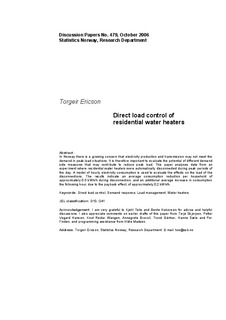| dc.contributor.author | Ericson, Torgeir | |
| dc.date.accessioned | 2011-11-14T19:53:29Z | |
| dc.date.available | 2011-11-14T19:53:29Z | |
| dc.date.issued | 2006 | |
| dc.identifier.issn | 1892-753x | |
| dc.identifier.uri | http://hdl.handle.net/11250/180679 | |
| dc.description.abstract | Abstract:
In Norway there is a growing concern that electricity production and transmission may not meet the
demand in peak-load situations. It is therefore important to evaluate the potential of different demand
side measures that may contribute to reduce peak load. This paper analyses data from an
experiment where residential water heaters were automatically disconnected during peak periods of
the day. A model of hourly electricity consumption is used to evaluate the effects on the load of the
disconnections. The results indicate an average consumption reduction per household of
approximately 0.5 kWh/h during disconnection, and an additional average increase in consumption
the following hour, due to the payback effect, of approximately 0.2 kWh/h. | no_NO |
| dc.language.iso | eng | no_NO |
| dc.publisher | Statistics Norway, Research Department | no_NO |
| dc.relation.ispartofseries | Discussion Papers;No. 479 | |
| dc.subject | Water heaters | no_NO |
| dc.subject | Load management | no_NO |
| dc.subject | Demand response | no_NO |
| dc.subject | Electricity consumption | no_NO |
| dc.title | Direct load control of residential water heaters | no_NO |
| dc.type | Working paper | no_NO |
| dc.subject.nsi | VDP::Social science: 200::Economics: 210::Economics: 212 | no_NO |
| dc.source.pagenumber | 34 s. | no_NO |
